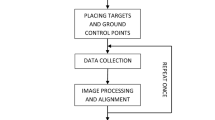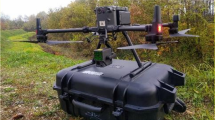Abstract
Traditional bridge inspection methods mostly rely on the experience and expertise of inspectors in visual detection of cracks. Such visual inspection methods are not only time consuming but also could be affected by subjective judgment of inspectors and lack a unified inspection standard. To overcome the shortcomings of visual inspection, this study investigates the feasibilities of using an unmanned aerial vehicle (UAV) combined with laser projectors to measure surface cracks. All related parameters of the laser projectors that are fixed on the UAV are calibrated first in the laboratory. Then, the UAV with the laser projectors is used to capture images of surface cracks. The images from the UAV can be transformed to orthoimages using the laser projectors’ parameters and the image processing technology. Next, surface cracks in the orthoimages are automatically identified by a crack identification algorithm. Finally, the characteristics of surface cracks are evaluated by the image-based measurement technologies. To verify the accuracy of the proposed image-based measurement system (UAV with laser projectors), seven artificial cracks with different widths are measured using the proposed measurement system and the point cloud method (UAV with the global navigation satellite system) under different measurement distances. The test results demonstrate that while the distance between the UAV and the artificial crack is within 150 cm, the proposed image-based measurement system is able to measure crack widths more accurately than the GNSS point cloud method. In addition, the proposed image-based measurement system can automatically identify surface cracks and measure crack widths from UAV-captured images without manual measurements.











Similar content being viewed by others
Availability of data and material
The supplementary information is available by request to Prof. Chang-Wei Huang.
Code availability
The code of the proposed method is available by request to Prof. Chang-Wei Huang.
References
M. Tirassa, M.F. Ruiz, A. Muttoni, Influence of cracking and rough surface properties on the transfer of forces in cracked concrete. Eng. Struct. 225, 111138 (2020). https://doi.org/10.1016/j.engstruct.2020.111138
M. Gimenes, E.A. Rodrigues, M.A. Maedo, L.A. Bitencourt, O.L. Manzoli, 2D crack propagation in high-strength concrete using multiscale modeling. Multiscale Sci. Eng. 2(2), 169–188 (2020). https://doi.org/10.1007/s42493-020-00049-y
Z. Chen, T.C. Hutchinson, Image-based framework for concrete surface crack monitoring and quantification. Adv. Civil Eng. (2010). https://doi.org/10.1155/2010/215295
H.G. Sohn, Y.M. Lim, K.H. Yun, G.H. Kim, Monitoring crack changes in concrete structures. Comput-Aided Civil Infrastruct. Eng. 20(1), 52–61 (2005). https://doi.org/10.1111/j.1467-8667.2005.00376.x
S. Park, S. Ahmad, C.B. Yun, Y. Roh, Multiple crack detection of concrete structures using impedance-based structural health monitoring techniques. Exp. Mech. 46(5), 609–618 (2006). https://doi.org/10.1007/s11340-006-8734-0
Z. Zhou, B. Zhang, K. Xia, X. Li, G. Yan, K. Zhang, Smart film for crack monitoring of concrete bridges. Struct. Health Monit. 10(3), 275–289 (2011). https://doi.org/10.1177/1475921710373288
S. Dorafshan, M. Maguire, Bridge inspection: human performance, unmanned aerial systems and automation. J. Civ. Struct. Heal. Monit. 8(3), 443–476 (2018). https://doi.org/10.1007/s13349-018-0285-4
M. Nakao, E. Hasegawa, T. Kudo, N. Sawasaki, Development of a Bridge Inspection Support Robot System Using Two-Wheeled Multicopters. J. Robot. Mechatron. 31(6), 837–844 (2019). https://doi.org/10.20965/jrm.2019.p0837
N. Metni, T. Hamel, A UAV for bridge inspection: visual servoing control law with orientation limits. Autom. Constr. 17(1), 3–10 (2007). https://doi.org/10.1016/j.autcon.2006.12.010
Dorafshan, S., Maguire, M., Hoffer, N. V., & Coopmans, C. (2017, June). Challenges in bridge inspection using small unmanned aerial systems: Results and lessons learned. In 2017 International Conference on Unmanned Aircraft Systems (ICUAS) (pp. 1722–1730). IEEE. https://doi.org/10.1109/ICUAS.2017.7991459.
N. Metni, J.M. Pflimlin, T. Hamel, P. Soueres, Attitude and gyro bias estimation for a VTOL UAV. Control. Eng. Pract. 14(12), 1511–1520 (2006). https://doi.org/10.1016/j.conengprac.2006.02.015
J.R. Azinheira, A. Moutinho, Hover control of an UAV with backstepping design including input saturations. IEEE Trans. Control Syst. Technol. 16(3), 517–526 (2008). https://doi.org/10.1109/TCST.2007.908209
M.D. Phung, C.H. Quach, T.H. Dinh, Q. Ha, Enhanced discrete particle swarm optimization path planning for UAV vision-based surface inspection. Autom. Constr. 81, 25–33 (2017). https://doi.org/10.1016/j.autcon.2017.04.013
H. Kim, J. Lee, E. Ahn, S. Cho, M. Shin, S.H. Sim, Concrete crack identification using a UAV incorporating hybrid image processing. Sensors 17(9), 2052 (2017). https://doi.org/10.3390/s17092052
I.H. Kim, H. Jeon, S.C. Baek, W.H. Hong, H.J. Jung, Application of crack identification techniques for an aging concrete bridge inspection using an unmanned aerial vehicle. Sensors 18(6), 1881 (2018). https://doi.org/10.3390/s18061881
B. Lei, N. Wang, P. Xu, G. Song, New crack detection method for bridge inspection using UAV incorporating image processing. J. Aerosp. Eng. 31(5), 04018058 (2018). https://doi.org/10.1061/(ASCE)AS.1943-5525.0000879
L. Duque, J. Seo, J. Wacker, Bridge deterioration quantification protocol using UAV. J. Bridg. Eng. 23(10), 04018080 (2018). https://doi.org/10.1061/(ASCE)BE.1943-5592.0001289
D. Reagan, A. Sabato, C. Niezrecki, Feasibility of using digital image correlation for unmanned aerial vehicle structural health monitoring of bridges. Struct. Health Monit. 17(5), 1056–1072 (2018). https://doi.org/10.1177/1475921717735326
A. Khaloo, D. Lattanzi, K. Cunningham, R. Dell’Andrea, M. Riley, Unmanned aerial vehicle inspection of the Placer River Trail Bridge through image-based 3D modelling. Struct. Infrastruct. Eng. 14(1), 124–136 (2018). https://doi.org/10.1080/15732479.2017.1330891
S. Jung, D. Choi, S. Song, H. Myung, Bridge inspection using unmanned aerial vehicle based on HG-SLAM: hierarchical graph-based SLAM. Remote Sensing 12(18), 3022 (2020). https://doi.org/10.3390/rs12183022
F. Lin, W.Y. Chang, L.C. Lee, H.T. Hsiao, W.F. Tsai, Remote Crack measuring system and device. J. Chin. Inst. Civil Hydraul. Eng. 26(2), 165–180 (2014). ((in Chinese))
S.K. Sinha, P.W. Fieguth, Automated detection of cracks in buried concrete pipe images. Autom. Constr. 15(1), 58–72 (2006). https://doi.org/10.1016/j.autcon.2005.02.006
A. Litorowicz, Identification and quantification of cracks in concrete by optical fluorescent microscopy. Cem. Concr. Res. 36(8), 1508–1515 (2006). https://doi.org/10.1016/j.cemconres.2006.05.011
T. Yamaguchi, S. Hashimoto, Fast crack detection method for large-size concrete surface images using percolation-based image processing. Mach. Vis. Appl. 21(5), 797–809 (2010). https://doi.org/10.1007/s00138-009-0189-8
T. Yamaguchi, S. Hashimoto, Practical image measurement of crack width for real concrete structure. Electron. Commun. Jpn. 92(10), 1–12 (2009). https://doi.org/10.1002/ecj.10151
Pix4D SA, (2017). Pix4Dmapper 4.1 User Manual.
Lidar360 (2018). Lidar360 User Guide V5.0. GreenValley Int., California.
Funding
This work was supported by the Ministry of Science and Technology, Taiwan [109-2221-E-033-001] and the Chung Yuan Christian University [109-CYCU-RG-12 and 110-CYCU-RG-07].
Author information
Authors and Affiliations
Contributions
KWC and CWH drafted the manuscript. LGH and KH performed experiments and analyzed related data. CWH and WCL supervised the research. All authors contributed to the discussion of the results and preparation of the manuscript.
Corresponding author
Ethics declarations
Conflict of interest
The authors declare that there is no conflict of interest.
Additional information
Publisher's Note
Springer Nature remains neutral with regard to jurisdictional claims in published maps and institutional affiliations.
Rights and permissions
About this article
Cite this article
Chou, KW., He, LG., Hsu, K. et al. Application of an Unmanned Aerial Vehicle for Crack Measurement Using Image Calibration Supported by Laser Projectors. Multiscale Sci. Eng. 3, 225–235 (2021). https://doi.org/10.1007/s42493-021-00072-7
Received:
Revised:
Accepted:
Published:
Issue Date:
DOI: https://doi.org/10.1007/s42493-021-00072-7




